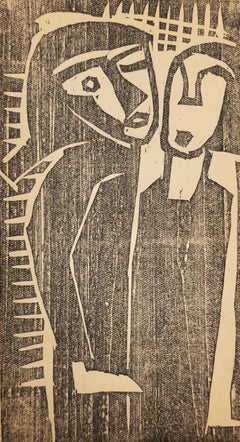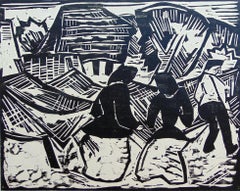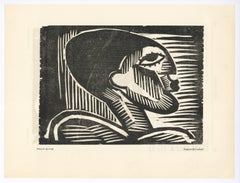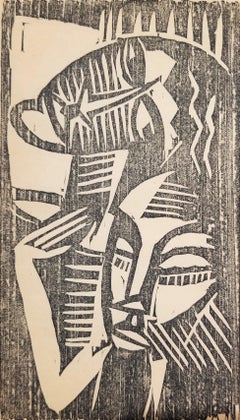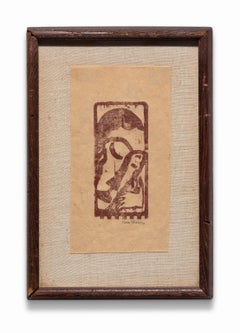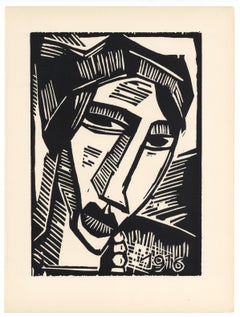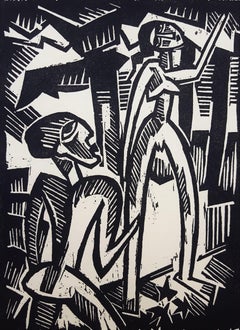Karl Schmidt-Rottluff Figurative Prints
German, 1884-1976
Karl Schmidt-Rottluff (born December 1, 1884, Rottluff, near Chemnitz, Germany—died August 9, 1976, West Berlin [now Berlin]), German painter and printmaker who was noted for his Expressionist landscapes and nudes.
In 1905 Schmidt-Rottluff began to study architecture in Dresden, Germany, where he and his friend Erich Heckel met Ernst Ludwig Kirchner and Fritz Bleyl, two other architecture students who shared their passion for painting. Together they formed the organization of Expressionist artists known as Die Brücke (“The Bridge”), united by the goal of creating a modern, intensely emotional style.
The artists of Die Brücke typically preferred to portray scenes of urban life, but Schmidt-Rottluff is particularly known for his rural landscapes. He initially painted in an Impressionist style, but his painting Windy Day (1907) shows the artist’s transition to his mature style, which is characterized by flat areas of boldly dissonant colours. A representative example of this mature work is Self-Portrait with Monocle (1910). Like the other Brücke artists, Schmidt-Rottluff had also begun to explore the expressive potential of the woodcut medium. In 1911 Schmidt-Rottluff, with his fellow Die Brücke members, moved to Berlin, where he painted works with more angular, geometric forms and distorted space, revealing his new interest in Cubism and African sculpture.
After World War I Schmidt-Rottluff became increasingly interested in religious themes, as seen in the woodcut Head of Christ (1918), which is one of a series of prints about the life of Christ. During the 1920s Schmidt-Rottluff’s work became more subdued and harmonious, losing much of its former vigour and integrity. When the Nazis gained power in Germany, he was forbidden to paint. After World War II he taught art and resumed painting, although he never regained the power of his early works.to
3
1
Overall Width
to
Overall Height
to
4
14
859
374
370
308
4
4
2
2
3
3
3
1
1
1
4
2
3
1
Artist: Karl Schmidt-Rottluff
Zwei Frauen (Two Women) /// German Expressionism Karl Schmidt-Rottluff Woodcut
By Karl Schmidt-Rottluff
Located in Saint Augustine, FL
Artist: Karl Schmidt-Rottluff (German, 1884-1976)
Title: "Zwei Frauen (Two Women)"
Portfolio: Das Spiel Christa vom Schmerz der Schönheit des Weibes (The Play Christa from the Pain of the Beauty of the Woman)
*Issued unsigned
Year: 1918
Medium: Original Woodcut Engraving on wove paper
Limited edition: Unknown
Printer: Fritz Voigt, Berlin, Germany
Publisher: Verlag Die Aktion, Berlin, Germany
Reference: Schapire No. 222, page 45; Jentsch No. 35. Rifkind No. 2563; Lang No. 300; Reed No. 118
Overall size with attached page: 8.5" x 10.63"
Sheet size: 8.5" x 5.38"
Image size: 6.5" x 3.63"
Condition: Toning to sheet (as normal). A few tiny pinholes in right margin. In very good condition
Very rare
Notes:
Provenance: private collection - Oxnard, CA. Comes from a complete originally bound 48 page folio with 9 original woodcut engravings by Schmidt-Rottluff. Text by Alfred Brust. Presently attached to its accompanying page. The cover and title pages in pictures are not included, only for reference/provenance. There is an example of this work in the permanent collection of the Brücke Museum, Berlin, Germany.
Biography:
Karl Schmidt-Rottluff (born December 1, 1884, Rottluff, near Chemnitz, Germany—died August 9, 1976, West Berlin [now Berlin]), German painter and printmaker who was noted for his Expressionist landscapes and nudes.
In 1905 Schmidt-Rottluff began to study architecture in Dresden, Germany, where he and his friend Erich Heckel met Ernst Ludwig Kirchner and Fritz Bleyl...
Category
1910s Expressionist Karl Schmidt-Rottluff Figurative Prints
Materials
Engraving, Woodcut
By the Nets - German Expressionism Woodcut Schmidt-Rottluff
By Karl Schmidt-Rottluff
Located in London, GB
KARL SCHMIDT-ROTTLUFF 1884-1976
Rottluff, Germany 1884 - 1976 Berlin (German)
Title: By the Nets Bei den Netzen, 1914
Technique: Original Hand Signed Woodcut on Laid Paper
Paper size: 51.2 x 62.4 cm. / 20.2 x 24.6 in.
Additional Information: This original woodcut is hand signed in pencil by the artist "S. Rottluff" at the lower right margin.
This is the fifth woodcut of the portfolio "Zehn Holzschnitte von Schmidt-Rottluff" [Ten Woodcuts by Schmidt-Rottluff] that was published in 1919.
It was published by Graphisches Kabinett J. B. Neumann, Berlin in a limited unnumbered edition of 75 plus some proofs.
The printer was Fritz Voigt...
Category
1910s Expressionist Karl Schmidt-Rottluff Figurative Prints
Materials
Woodcut
"Männlicher Kopf" original woodcut
By Karl Schmidt-Rottluff
Located in Henderson, NV
Medium: original woodcut. Printed in Germany in 1917 for Die Aktion; this impression is from the deluxe edition of 100 on Bütten laid paper. Catalogue reference: Schapire 202. Image ...
Category
1910s Expressionist Karl Schmidt-Rottluff Figurative Prints
Materials
Woodcut
Männlicher Kopf an weibliche (Male Head Leaning against Female) /// Rottluff
By Karl Schmidt-Rottluff
Located in Saint Augustine, FL
Artist: Karl Schmidt-Rottluff (German, 1884-1976)
Title: "Männlicher Kopf an weibliche (Male Head Leaning against Female)"
Portfolio: Das Spiel Christa vom Schmerz der Schönheit des Weibes (The Play Christa from the Pain of the Beauty of the Woman)
*Issued unsigned
Year: 1918
Medium: Original Woodcut Engraving on wove paper
Limited edition: Unknown
Printer: Fritz Voigt, Berlin, Germany
Publisher: Verlag Die Aktion, Berlin, Germany
Reference: Schapire No. 225, page 46; Jentsch No. 35. Rifkind No. 2563; Lang No. 300; Reed No. 118
Sheet size: 8.5" x 5.38"
Image size: 6.25" x 3.57"
Condition: Toning to sheet (as normal). In very good condition
Very rare
Notes:
Provenance: private collection - Oxnard, CA. Comes from a complete originally bound 48 page folio with 9 original woodcut engravings by Schmidt-Rottluff. Text by Alfred Brust. The cover and title pages in pictures are not included, only for reference/provenance. There is an example of this work in the permanent collection of the Brücke Museum, Berlin, Germany.
Biography:
Karl Schmidt-Rottluff (born December 1, 1884, Rottluff, near Chemnitz, Germany—died...
Category
1910s Expressionist Karl Schmidt-Rottluff Figurative Prints
Materials
Engraving, Woodcut
Related Items
Max Weber Woodcut Print from "Primitives" Poetry Book Signed
By Max Weber
Located in Detroit, MI
ONE WEEK ONLY SALE
This woodcut print is an expressionist print on one of the poems from Max Weber's poetry collection "Primitives: Poems and Woodcuts". This work is signed in penci...
Category
1920s Expressionist Karl Schmidt-Rottluff Figurative Prints
Materials
Woodcut
Dancing in the Dark
By Joan Snyder
Located in New York, NY
Joan Snyder has been called an autobiographical, even confessional artist, who draws from her experiences and surroundings to create her paintings. While her subjects vary widely, Sn...
Category
1980s Expressionist Karl Schmidt-Rottluff Figurative Prints
Materials
Woodcut
SITZENDER HARLEKIN
By Heinrich Campendonk
Located in Portland, ME
Campendonk, Heinrich. SITZENDER HARLEKIN. Engels/Sohn 59. Woodcut, 1922. 15 x 11 3/8 inches; 380 x 290 mm. Signed in pencil. In Excellent condition. Framed.
Category
20th Century Expressionist Karl Schmidt-Rottluff Figurative Prints
Materials
Woodcut
'Theater' — 1920s German Expressionism
Located in Myrtle Beach, SC
A German Expressionist woodcut, with original hand-coloring in watercolor, depicting a parent and child watching a theatrical production; ...
Category
1920s Expressionist Karl Schmidt-Rottluff Figurative Prints
Materials
Woodcut
'Elisabeth' — German Expressionism
By Karl Michel
Located in Myrtle Beach, SC
Karl Michel, 'Elisabeth', woodcut, edition 20, 1923. Signed, dated, and numbered 'op.142b' and '12/20' in pencil. Signed in the block, lower left. Annotated 'Vorgesdruck' [artist’s proof] in pencil.
A fine impression, on heavy fibrous Japan paper, with full margins (1 3/16 to 3 1/2 inches),
in good condition. Printed by the artist, With the artist’s blindstamp in the bottom center margin. Scarce. Matted to museum standards, unframed.
Image size 4 15/16 x 6 inches (131 x 152 mm); sheet size 10 x 6 inches (254 x 152 mm).
ABOUT THE ARTIST
Karl Michel (1889-1984) was a noted graphic designer and expressionist printmaker during Germany's pre-Nazi Weimar Republic (1919-1933). Michel’s work was the subject of a feature article in the influential German graphic design magazine Das Plakat (The Poster) in 1920. An anti-war advocate, Michel created a suite of 12 wood engravings depicting his impressions of the humanitarian toll of WWII entitled ‘Humanitas’ (Humanity). The German publishing house Greifenverlag published the series in a reduced folio of unsigned prints.
Michel’s graphic work is held in the permanent collections of the Auckland War Memorial Museum (New Zealand), Frederikshavn Kunstmuseum & Exlibrissamling (Denmark), Museum of Applied Arts (Budapest), The Robert Gore Rifkind Center for German Expressionist Studies at the Los Angeles County Museum of Art, and the German Expressionism...
Category
1920s Expressionist Karl Schmidt-Rottluff Figurative Prints
Materials
Woodcut
'Mehr Sonne fur 1924' (More Sun for 1924)— German Expressionism
By Karl Michel
Located in Myrtle Beach, SC
Karl Michel, 'Mehr Sonne fur 1924. Viel Gluck Wunscht Karl Michel U. Frau', woodcut, 1924, edition 20. Signed, dated, and numbered 'op. 162' and '15/20' in pencil. Signed in the image, lower left. A fine, richly-inked impression on buff wove paper, with full margins (1 1/2 to 2 3/4 inches), in very good condition. Printed by the artist. Scarce. Matted to museum standards, unframed.
New Year's Greeting – English translation: "More Sun for 1924. Good Luck Wishes from Karl Michel and his Wife."
Image size 4 5/8 x 4 3/4 inches (118 x 121 mm); sheet size 7 3/4 x 10 inches (198 x 254 mm).
ABOUT THE ARTIST
Karl Michel (1889-1984) was a noted graphic designer and expressionist printmaker during Germany's pre-Nazi Weimar Republic (1919-1933). Michel’s work was the subject of a feature article in the influential German graphic design magazine Das Plakat...
Category
1920s Expressionist Karl Schmidt-Rottluff Figurative Prints
Materials
Woodcut
$400
H 4.63 in W 4.75 in D 0.01 in
'Der Gartner' (The Gardener) — German Expressionism
By Karl Michel
Located in Myrtle Beach, SC
Karl Michel, 'Der Gartner' (The Gardener), woodcut, c. 1925. Signed, titled, and numbered '15/50' in pencil. Signed in the block, lower left and right. A fine, richly-inked impression on buff wove paper, with full margins (1 1/2 to 2 3/4 inches), in excellent condition. Matted to museum standards, unframed. Scarce.
Image size 5 1/4 x 3 7/8 inches (133 x 98 mm); sheet size 10 x 7 3/4 inches (254 x 198 mm).
ABOUT THE ARTIST
Karl Michel (1889-1984) was a noted graphic designer and expressionist printmaker during Germany's pre-Nazi Weimar Republic (1919 - 1933). In 1920, his work was featured in the influential German graphic design magazine Das Plakat...
Category
1920s Expressionist Karl Schmidt-Rottluff Figurative Prints
Materials
Woodcut
$375
H 5.25 in W 3.88 in D 0.01 in
My Work
By Joan Snyder
Located in New York, NY
Joan Snyder has been called an autobiographical, even confessional artist, who draws from her experiences and surroundings to create her paintings. While her subjects vary widely, Sn...
Category
1990s Expressionist Karl Schmidt-Rottluff Figurative Prints
Materials
Etching, Woodcut
Rabbis Studying the Thorah
By Jacob Steinhardt
Located in San Francisco, CA
Artist: Jakob Steinhardt (German/Israeli, 1887-1968)
Title: Rabbis Studying the Thorah
Year: Circa 1960
Medium: Color woodcut
Paper: Wove
Image size...
Category
Mid-20th Century Expressionist Karl Schmidt-Rottluff Figurative Prints
Materials
Woodcut
'Venus' — German Expressionism
By Karl Michel
Located in Myrtle Beach, SC
Karl Michel, 'Venus, Ex Libris - Hanns U. Herta Heeren', woodcut, 1923, edition not stated but small. Signed, dated, and numbered 'op.154' in pencil. Signed in the block, lower left. A fine impression, on cream Japan paper, with full margins (15/16 to 2 11/16 inches), in good condition. Printed by the artist. Matted to museum standards (unframed).
.
Translation: Venus Ex Libris for Hanns and Herta Heeren.
Image size 5 15/16 x 4 inches (156 x 102 mm); sheet size 9 5/8 x 6 inches (245 x 152 mm).
ABOUT THE ARTIST
Karl Michel (1889-1984) was a noted graphic designer and expressionist printmaker during Germany's pre-Nazi Weimar Republic (1919-1933). Michel’s work was the subject of a feature article in the influential German graphic design magazine Das Plakat (The Poster) in 1920. An anti-war advocate, Michel created a suite of 12 wood engravings depicting his impressions of the humanitarian toll of WWII entitled ‘Humanitas’ (Humanity). The German publishing house Greifenverlag published the series in a reduced folio of unsigned prints.
Michel’s graphic work is held in the permanent collections of the Auckland War Memorial Museum (New Zealand), Frederikshavn Kunstmuseum & Exlibrissamling (Denmark), Museum of Applied Arts (Budapest), The Robert Gore Rifkind Center for German Expressionist Studies at the Los Angeles County Museum of Art, and the German Expressionism...
Category
1920s Expressionist Karl Schmidt-Rottluff Figurative Prints
Materials
Woodcut
'Viel Gluck 1923' (Good Luck Wishes) — German Expressionism
By Karl Michel
Located in Myrtle Beach, SC
Karl Michel, 'Viel Gluck 1923 Wunscht der Graphikverlag, J.G. Holzwarth/Bad Rothenfelde', woodcut, 1922, edition 20. Signed and numbered op. 135d and 20/20 in pencil. Signed in the image, lower left. Annotated 'Vorgesdruck' [artist’s proof] in pencil. A fine, richly-inked impression, on heavy, cream Japan paper, with full margins (5/8 to 1 1/8 inches), in good condition. With the artist’s blind stamp in the top left margin. Printed by the artist. Matted to museum standards, unframed.
New Year's Greeting - "1923, Good Luck Wishes from the Graphic Press, J.G. Holzwarth/Bad Rothfelde."
Image size 5 x 3 1/2 inches (127 x 89 mm); sheet size 6 5/8 x 5 7/8 inches (168 x 149 mm).
ABOUT THE ARTIST
Karl Michel (1889-1984) was a noted graphic designer and expressionist printmaker during Germany's pre-Nazi Weimar Republic (1919-1933). Michel’s work was the subject of a feature article in the influential German graphic design magazine Das Plakat (The Poster) in 1920. An anti-war advocate, Michel created a suite of 12 wood engravings depicting his impressions of the humanitarian toll of WWII entitled ‘Humanitas’ (Humanity). The German publishing house Greifenverlag published the series in a reduced folio of unsigned prints.
Michel’s graphic work is held in the permanent collections of the Auckland War Memorial Museum (New Zealand), Frederikshavn Kunstmuseum & Exlibrissamling (Denmark), Museum of Applied Arts (Budapest), The Robert Gore Rifkind Center for German Expressionist Studies at the Los Angeles County Museum of Art, and the German Expressionism...
Category
1920s Expressionist Karl Schmidt-Rottluff Figurative Prints
Materials
Woodcut
$300
H 5 in W 3.5 in D 0.01 in
AGONY
Located in Santa Monica, CA
ROBERT PHILIPPI (Austrian 1877-1959)
KNEELING NUDE. c. 1923 (Chrastek, Widder 2019, p. 162, N° 461) (in Rifkind Collection, LACMA: From a portfolio of 1...
Category
1920s Expressionist Karl Schmidt-Rottluff Figurative Prints
Materials
Woodcut
Previously Available Items
"Frauenkopf" original woodcut
By Karl Schmidt-Rottluff
Located in Henderson, NV
Medium: original woodcut. Printed in 1920 for the Deutsche Graphiker der Gegenwart portfolio, and published in Leipzig by Klinkhardt & Biermann in an edition of 500. Catalogue refere...
Category
1910s Expressionist Karl Schmidt-Rottluff Figurative Prints
Materials
Woodcut
Menschenpaar (Couple)
By Karl Schmidt-Rottluff
Located in Saint Augustine, FL
An original woodcut engraving on cream wove paper by German artist Karl Schmidt-Rottluff (1884-1976) titled "Menschenpaar (Couple)", 1917. Issued unsigned. Limited edition: 110. Come...
Category
1910s Expressionist Karl Schmidt-Rottluff Figurative Prints
Materials
Engraving, Woodcut
Christus under dem Frauen (Christ Among the Women)
By Karl Schmidt-Rottluff
Located in Chicago, IL
Woodcut: edition of 90
397 x 500 mm.; 15 5/8 x 19 5/8 inches
Signed and numbered
References:
Rathenau 85
Hirmer Verlag 60
Note:
A fine and moving impression of this major ...
Category
1910s Brücke Karl Schmidt-Rottluff Figurative Prints
Materials
Woodcut
Mädchen vor dem Spiegel (Girl before a Mirror)
By Karl Schmidt-Rottluff
Located in Chicago, IL
One of Schmidt-Rottluff's must powerful, expressionist works. This impression is signed lower right and comes from an edition of 75. References: Schapire 159; Hirmer Verlag 33
Category
1910s Expressionist Karl Schmidt-Rottluff Figurative Prints
Materials
Woodcut
Karl Schmidt-rottluff figurative prints for sale on 1stDibs.
Find a wide variety of authentic Karl Schmidt-Rottluff figurative prints available for sale on 1stDibs. You can also browse by medium to find art by Karl Schmidt-Rottluff in woodcut print, engraving and more. Much of the original work by this artist or collective was created during the 1910s and is mostly associated with the Expressionist style. Not every interior allows for large Karl Schmidt-Rottluff figurative prints, so small editions measuring 6 inches across are available. Customers who are interested in this artist might also find the work of Emil Nolde, Lovis Corinth, and Emil Orlik. Karl Schmidt-Rottluff figurative prints prices can differ depending upon medium, time period and other attributes. On 1stDibs, the price for these items starts at $650 and tops out at $20,000, while the average work can sell for $1,500.
